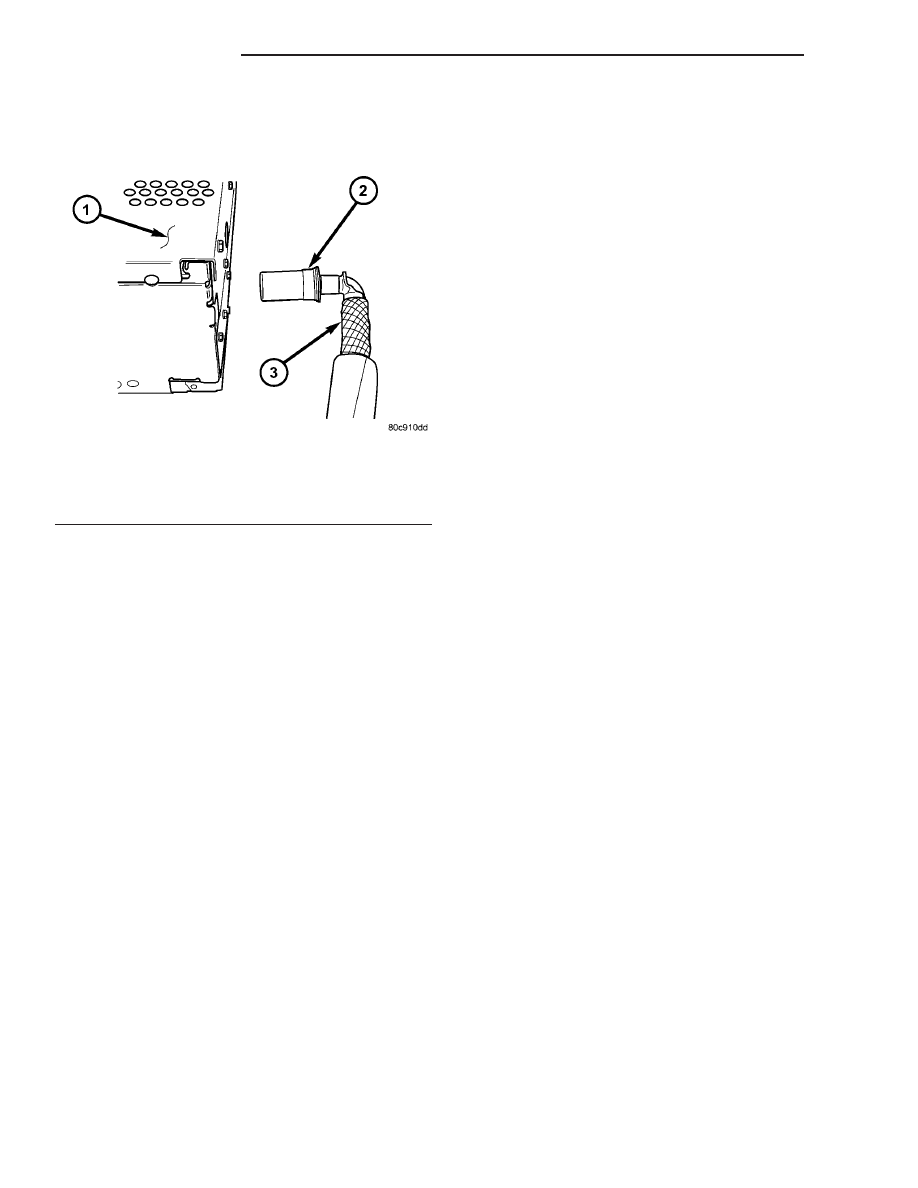Chrysler PT Cruiser. Manual - part 469

(5) Disconnect the antenna cable by pulling the
locking antenna connector away from the radio (Fig.
9).
INSTALLATION
(1) Connect
the
wire
harness
connector
and
antenna cable to radio.
(2) Insert radio into instrument panel.
(3) Install mounting fasteners. Tighten to 2 N·m
(20 in. lbs.).
(4) Install instrument panel center bezel.
(5) Connect battery negative cable.
RADIO NOISE SUPPRESSION
COMPONENTS
DESCRIPTION
Radio noise suppression devices are factory-in-
stalled standard equipment on this vehicle. Radio
Frequency Interference (RFI) and ElectroMagnetic
Interference (EMI) can be produced by any on-board
or external source of electromagnetic energy. These
electromagnetic energy sources can radiate electro-
magnetic signals through the air, or conduct them
through the vehicle electrical system.
When the audio system converts RFI or EMI to an
audible acoustic wave form, it is referred to as radio
noise. This undesirable radio noise is generally man-
ifested in the form of “buzzing,” “hissing,” “popping,”
“clicking,” “crackling,” and/or “whirring” sounds. In
most cases, RFI and EMI radio noise can be sup-
pressed using a combination of vehicle and compo-
nent grounding, filtering and shielding techniques.
This vehicle is equipped with factory-installed radio
noise suppression devices that were designed to min-
imize exposure to typical sources of RFI and EMI;
thereby, minimizing radio noise complaints.
Radio noise suppression is accomplished primarily
through circuitry or devices that are integral to the
radios, audio power amplifiers and other on-board
electrical components such as generators, wiper
motors, blower motors, and fuel pumps that have
been found to be potential sources of RFI or EMI.
External radio noise suppression devices that are
used on this vehicle to control RFI or EMI, and can
be serviced, include the following:
• Ground straps - This length of braided ground
strap has an eyelet terminal connector crimped to
each end. They are located in various locations on
the vehicle.
• Radio Noise Suppression Capacitor - This
component is attached near the exhaust manifold.
• Resistor-type spark plugs - This type of spark
plug has an internal resistor connected in series
between the spark plug terminal and the center elec-
trode to help reduce the production of electromag-
netic radiation that can result in radio noise.
OPERATION
There are two common strategies that can be used
to suppress Radio Frequency Interference (RFI) and
ElectroMagnetic Interference (EMI) radio noise. The
first suppression strategy involves preventing the
production of RFI and EMI electromagnetic signals
at their sources. The second suppression strategy
involves preventing the reception of RFI and EMI
electromagnetic signals by the audio system compo-
nents.
The use of braided ground straps in key locations
is part of the RFI and EMI prevention strategy.
These ground straps ensure adequate ground paths,
particularly for high current components such as
many of those found in the starting, charging, igni-
tion, engine control and transmission control sys-
tems. An insufficient ground path for any of these
high current components may result in radio noise
caused by induced voltages created as the high cur-
rent seeks alternative ground paths through compo-
nents or circuits intended for use by, or in close
proximity to the audio system components or circuits.
Preventing the reception of RFI and EMI is accom-
plished by ensuring that the audio system compo-
nents are correctly installed in the vehicle. Loose,
corroded or improperly soldered wire harness connec-
tions, improperly routed wiring and inadequate audio
system component grounding can all contribute to
the reception of RFI and EMI. A properly grounded
antenna body and radio chassis, as well as a shielded
antenna coaxial cable with clean and tight connec-
tions will each help reduce the potential for reception
of RFI and EMI.
Fig. 9 ANTENNA TO RADIO
1 - RADIO
2 - LOCKING ANTENNA CONNECTOR
3 - INSTRUMENT PANEL ANTENNA CABLE
8A - 12
AUDIO/VIDEO
PT
RADIO (Continued)